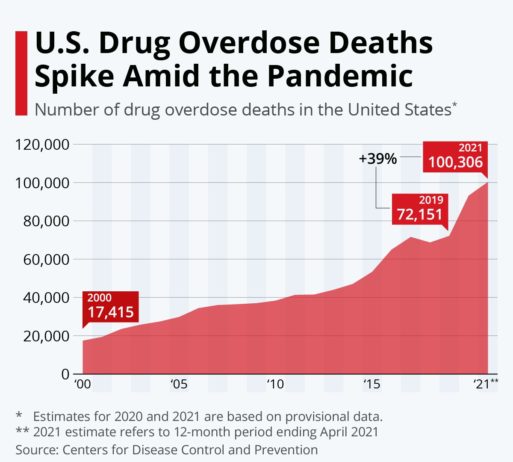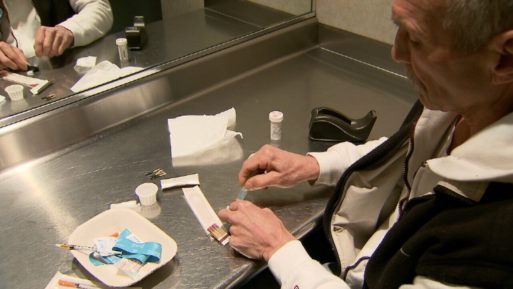
Teenagers in the U.S. are increasingly at risk of death from drug overdose
A new analysis of drug overdose deaths in the U.S. shows that young people between the ages of 10-24 lost a total of over 1 million cumulative years of life to drug overdoses between 2014 and 2019. Led by Dr. O. Trent Hall, D.O. of Ohio State University Wexner Medical Center in Columbus, a team of researchers analyzed data from the CDC’s Wide-Ranging Online Data for Epidemiologic Research (CDC WONDER) database to examine causes of death in young people during the preceding 5 years. In all, 22,000 overdose deaths were recorded in those 10-24 years of age, which, based on estimated life expectancy, calculated to approximately 1.23 million years of young lives lost.
“Unintentional drug overdose has become a grave and sustained public health burden in the U.S.,” the researchers wrote in a letter to JAMA Pediatrics, noting that most epidemiological studies have focused on adults. Yet the number of teenagers and young adults dying from unintentional overdose is also increasing across the U.S.
This troubling trend has important implications for society as a whole, the study authors wrote. “The death of a young person isn’t a single event. It is a tragedy that unfolds over a lifetime,” Hall said. “Adolescents and young adults dying of overdose are deprived of many years of work, community, and family life. Our study shows overdose mortality among adolescents and young people is unacceptably high. Public health interventions to protect this vulnerable group are urgently needed,” he said.
Prior research points to a number of psychosocial factors that put young people at risk of drug misuse, overdose and death. These include intravenous drug use, opioid and tranquilizer use, and polysubstance use (the use of multiple drugs of abuse, including opioids, tranquilizers and cocaine). Co-existing mental health disorders, unstable housing, a history of incarceration and witnessing an overdose death also heightened the risk of overdose.

A chart from Statista shows the dramatic increase in overdose deaths
Nor are young lives the only lives being lost at an alarming pace. Across all age groups, overdose deaths continue to increase throughout the U.S. Overshadowed in part by the COVID-19 pandemic, overdose deaths rose by 28% between April 2020 and April 2021, reaching an estimated 100,300 lives lost to drugs. Natural and synthetic opioids, including heroin, fentanyl, and prescription pain pills were associated with the majority of these deaths. But deaths from stimulants such as methamphetamine and cocaine also increased.
New Strategies to Prevent Drug Overdose
Public health experts have long been calling for new strategies to help combat the opiate crisis and save lives. But this is the first study that focused entirely on the impact of the crisis on the young. “We hope our report will raise awareness of the increasingly dire consequences of unintentional drug overdose among this vulnerable population,” said Dr. Julie Teater, a psychiatrist and addiction medicine specialist in Ohio State’s Department of Psychiatry and Behavioral Health and the senior author of the study. “Our study provides important context to the overdose crisis by better representing what it means to society when we lose adolescents and young people to unintentional drug overdose,” she said.
Some strategies that are already in place to stem the tide of overdose deaths include education and outreach in community centers and schools. But a far more comprehensive and wide-reaching approach is needed to truly make an impact, experts say. According to the Substance Abuse and Mental Health Services Administration, policymakers must begin to focus on harm reduction as well as prevention, treatment and recovery. The agency’s recommendations include
~Connecting those at risk to overdose education and counseling and referring them to healthcare providers as needed
~Distributing opioid reversal medications (naloxone or Narcan) to those at risk or those who might be present during an overdose event. (Dr. Hall recommends having naloxone in schools.)
~Equipping those who inject drugs with accurate information about how to mitigate risk

A man prepares to consume drugs at a safe consumption site in Vancouver, Canada
Credit: ctvnews.ca
The agency falls short of recommending a “safe supply” strategy, which aims to provide drug users with a safe place to consume drugs and access to tools to detect contaminants such as illegally manufactured fentanyl. Such centers have been implemented in multiple countries, including Australia, Canada and parts of Europe, with considerable success. However, here in the U.S., where the “War on Drugs” wages on, the Justice Department has fought aggressively against similar sites.
But that may be about to change. In early February, the agency hinted that it might be willing to entertain the idea in a statement to AP. “Although we cannot comment on pending litigation” [the department is suing to shut down a safe injection site in Philadelphia] “the Department is evaluating supervised consumption sites, including discussions with state and local regulators about appropriate guardrails for such sites, as part of an overall approach to harm reduction and public safety.”
Perhaps the grim milestone of over 100,000 drug overdose deaths in one year has finally spurred a much-needed policy change.

 Over 1 Million Years of Young Life Lost Due to Drug Overdose, Study Shows
Over 1 Million Years of Young Life Lost Due to Drug Overdose, Study Shows


 “Help Me, Helen”
“Help Me, Helen”

 “As Tears Go By” by Marianne Faithfull
“As Tears Go By” by Marianne Faithfull














